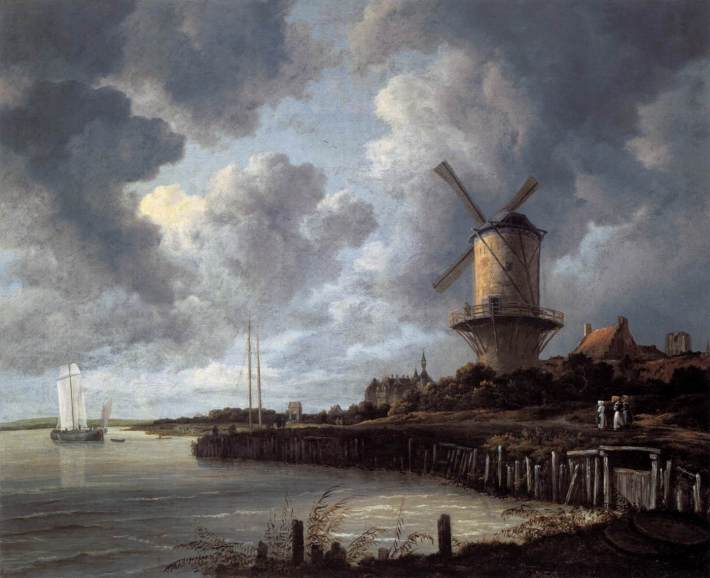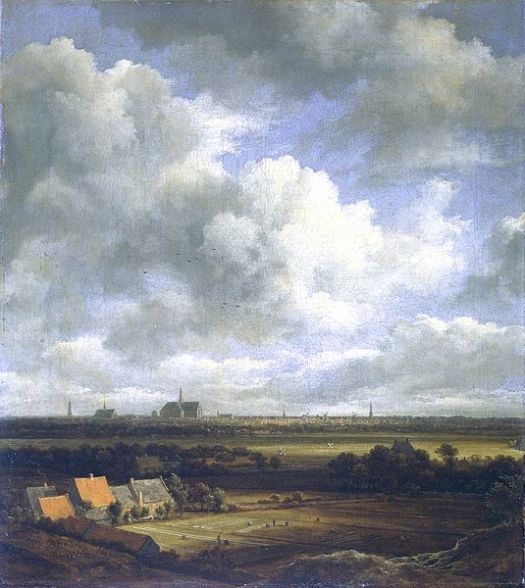When looking at modern day Art I idolize landscape photographers such as Peter Lik or Clark Little, the beauty of the great land which they are able to capture. Therefore, when looking at the Baroque Era of Art, who better to look at then one of the landscape pioneers, Jacob Isaakszoon van Ruisdael. The Dutch painter Ruisdael was born in the Netherlands to a family of painters. Although his personal style is unlike the rest.
This painting, The Windmill at Wijk bij Duurstede, created in 1670, shows Ruisdael style of simplicity and everyday items, a style which was made for the common man. The rise of the merchant classes during the Baroque Era lead to a market for simple, everyday paintings, which in turn fit for the style of Ruisdael. Such as the Still Life paintings which began during this same time period, landscape paintings to drew attention, being something the common man could relate to. After all landscapes capture the natural beauty of everyday items, like the windmill, the boat in the water, or the women walking down the street as shown above.
View of Harlem, created in 1670 shows what some consider to be what Ruisdael was really after in creating such works. While his paintings and style are simple enough to speak to the common man, many say that in reality his work was a, “metaphor of human psychology, specifically its darker aspects. Through the work of Jacob van Ruisdael landscape painting was no longer simply a record of how nature was perceived but rather it came to symbolize a deeper aspect that reflected the very soul of humankind.” Whether or not Ruisdael was meaning to create a one-two punch of simplistic style and deeper meaning will never really be known, but he did help pave the way for generations of Landscape artists, and artists in general to attempt to pursue such greatness.
Work Cited:
van Ruisdael, Jacob. View of Harlem. 1670. Rijksmuseum Amsterdam, Amsterdam. Wikipedia. Web. 22 February 2013.
van Ruisdael, Jacob. The Windmill at Wijk bij Duurstede. 1670. Rijksmuseum Amsterdam, Amsterdam. Wikipedia. Web. 22 February 2013.
“Jacob Isaakszoon van Ruisdael.” Wikipedia. N.p., 21 Feb 2013. Web. 22 Feb 2013. <http://en.wikipedia.org/wiki/Jacob_Isaakszoon_van_Ruisdael>.
“Jacob van Ruisdael.” Artble. N.p.. Web. 22 Feb 2013. <http://www.artble.com/artists/jacob_van_ruisdael>.


Oh!! I am so glad that you picked this artist. I really enjoy landscape paintings as well. I was having trouble picking between Claude Lorrain and Artemisia Gentileschi. In the end, I chose Artemisia Gentileschi because I thought her work, for being such a young artist, was just amazing and very emotionally gripping. However Lorrain’s work was spectacular. His piece, “Apollo and the Muses on Mount Helion,” is a favorite of mine. Anyways, I really like how you made a connection with this artist instead of just picking a random painter and I thought that you did a great job of analyzing the paintings as well. Thank you for sharing.
Although I would have chosen Claude Lorrain, Gentileschi work is emotionally gripping as you said! Even the “Still Life” type paintings I feel is very unique compared to other artists of the time period. I would have chosen Lorrain simply because I like to look at what towns looked like during that time period, as simple and almost silly as it sounds. Also it is interesting how paintings of buildings has evolved to the photography of buildings, as most of Lorrain’s work incorporates buildings, to the work which I find interesting today of arts like Clark Little, but unfortunately I can not seem to find it any links to the piece as it is hanging in his Hilo, Hawaii gallery.
I really enjoyed your description and blog write of Jacob Isaakszoon van Ruisdael’s landscape paintings. I was more framaliar with seeing portraits, paintings, and statues that include characthers, so learning about the landcape paintings was refreshing. I think his landscape paintings are beautiful and so realalistic, full of detail. Great job describing some of the detail and artistic values in these paintings.
Thanks